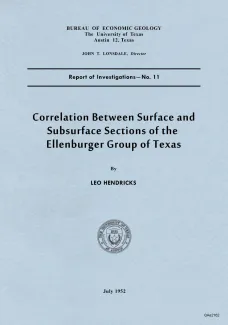
Publication Details
Geolocation:
Get the Publication
$37.00
Abstract/Description:
The Ellenburger of Texas was first defined as a marine limestone formation of Cambrian and Ordovician age (Paige, 1912), but recently it has been subdivided into several formations and the term Ellenburger given group status (Cloud and Barnes, 1948). The group forms an important unit in the geology of Texas, its known extent in both surface and subsurface covering approximately one-half of the State (fig. 1). Consequently the Ellenburger has received the attention of many geologists over a period of more than forty years. The greatest amount of information concerning the Ellenburger has come from wells drilled in exploration for oil and gas. This information from the subsurface is the basis for present concepts of the lateral extent and regional changes m thickness and lithologic character of the group (Sellards, 1933b). The top of the group serves as an important key horizon for mapping structure in the subsurface of large parts of north, central, and southwest Texas (Sellards and Hendricks, 1946). Data from well samples and cores have been used to make qualitative subdivisions and correlations within the formation (Cole, 1942, p. 1398; Crowley and Hendricks, 1945, p. 413). No paleontological correlations are possible from well data because well samples and cores from the Ellenburger are practically barren of fossils.